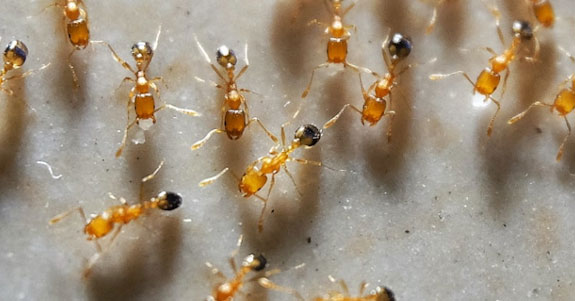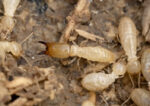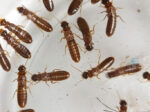
Florida Ant Species: Common Ants in West Palm Beach
As established experts in the field of pest control, we often hear questions such as “what kind of ants are in Florida?”, and “what are the similarities and differences between the various Florida ant species?”. The reality is that South Florida ants cause problems for many home and business owners throughout the region. Ants are a pest and a nuisance in a plethora of ways in South Florida. Certain species of ants are known to invade your home and forage your kitchen for food, like Ghost Ants. Whereas Big Headed Ants can make large mounds or nests and damage your landscape or pavers. Other species of ants, like White Footed Ants, are known to infest humid and damp areas like your attics or within the walls of your bathrooms. And perhaps worst of all, Fire Ants can be a hazard because they are aggressive if they are disturbed and will bite and sting and may cause painful irritation to your family or pets. Unfortunately, most of these ants not only can be found in West Palm Beach and other parts of Palm Beach County, but they are also prevalent in Broward County, Miami Dade County, Collier County, and most of the surrounding South Florida.
For this reason, it is essential to know what attracts these pests to homes and properties, their lifecycle, and behavioral habits, as well as which types of South Florida ants may pose a danger to humans and other animals. To properly address the problem of Florida ant species, correct identification of the ants is crucial so that West Palm Beach pest control experts such as the trained and certified technicians at Hulett Environmental Services can administer the best treatment protocols and establish a defense system to protect your space well into the future.
What Attracts Florida Ant Species?
Different species of ants prefer to make their home in different environments, but a few variables remain the same. South Florida ants are attracted to spaces where there is:
Safety to build a colony at the ideal temperature and humidity.
Where there is an ample and ready food and water source.
And where they can hide their main nest and stay protected.
Unfortunately for many home and business owners, this is often inside your dwelling or around your property. Some hiding places for nests can be particularly difficult for homeowners to find, like underneath attic insultation or in a sprinkler or meter box.
Many Florida ant species are attracted to sources of carbs and sugar, making pantries and kitchens their perfect feeding ground. Cabinets, countertops, and anywhere else kids may have spilled syrup, or their morning cereal or cup of juice can all attract ants. Just a small amount of sweet residue can attract many types of ants and cause them to invade from the outside and search your home for food. Some ants may also gravitate towards stored food products or even pet food. Whereas other species prefer oily or fatty substances, causing them to congregate around garbage cans or food spillage. I know this sounds like a lot to keep in mind, which is why consulting with a professional pest control company is recommended.
It is also important to keep in mind that ants are always on the hunt for sources of water, and ants in South Florida tend to live in damp environments. Ants can be found nesting near standing water, such as overflowing planters, pails, or other damp areas such as bathrooms can all be appealing to these creatures. If there has been a previous plumbing leak in the kitchen or bathroom near a sink, or a window or door has leaked, this can also provide a suitable habitat for ants to nest.
Ants are always on the lookout for good places to colonize and nest. For example, Carpenter Ants will commonly invade your home or property looking for nesting areas inside of wet or rotting wood. They can be found in attics if there has been an attic leak, or Carpenter Ants can also be found infesting old sheds or garages, or wooden railings that are exposed to the outside rain. Sometimes these nesting places are in your yard, too! Decaying organic matter that can be found in gardens, landscaping debris, dying trees, and yard waste are also all great nesting sites for ant species in South Florida.
Are Florida Ant Species Dangerous?
We often receive questions regarding whether ants are dangerous to humans and pets. The answer is that, yes, they can be in some instances. There are some South Florida ants that can potentially pose a health risk to people and animals. The most notable species of ant that can cause negative health reactions is the Fire Ant, which can leave behind itchy, sweltering bites on both humans as well as household animals. You may also hear this type of ant referred to as red ants. This species of ant is known to sting multiple times when they attack in groups. In rare instances, if you are allergic, fire ant stings can potentially cause a medical emergency. Elongate Twig Ants are known to nest in twigs and are also able to deliver a very painful sting.
Types of Ants in Florida & West Palm Beach
If you are noticing these little scurrying creatures in and around your home, you may be wondering what kind of ants are in Florida and what you can do to eradicate them from your property. If you are a business owner, this becomes even more critical, as an ant problem can severely damage your reputation with the public, leading to customer complaints and negative online reviews, especially if you sell food. Do not wait to address a problem with South Florida ants.
Only a professional can properly identify which species of ant is invading your home or business and can then develop an effective treatment plan to rid your space of the invaders. The qualified inspectors at Hulett Environmental Services have been trained by a staffed Board-Certified Entomologist on how to properly inspect and identify pests for homes and businesses in need of pest control. Our inspectors can identify pests, indicators of pest activity, and conducive conditions within your home or on your property that may be attracting the pests to invade. Once the proper identification is made and confirmed by our Entomologist, our certified applicators can select the precise treatment using products designed for the exact target pest. For this reason, if you believe that you may have an ant infestation, it is best to contact Hulett Environmental Services right away for a free inspection with no obligation. Often, home and business owners attempt to solve ant problems on their own, and instead end up spending more money in the long-run on treatment options that simply didn’t work, especially if the ant or pest is misidentified.
Bigheaded Ants
Big-Headed Ants are among the most common Florida ant species. The Big-Headed Ant is an invasive species, meaning that it can cause ecological or economic harm to their new environments as it takes over. Invasive species are particularly harmful because they can kill off native plants and animal species, causing an imbalance in the local ecosystem. They reduce much-needed biodiversity and alter the habitats they live in.
The Big-Headed Ant can be dangerous to native ant species and is known as one of the world’s top 100 worst invaders. Some believe this ant species made its way into the region following a series of particularly active hurricane seasons that resulted in the transportation of driftwood. Also, when large amounts of plants, grass and lawns were washed away, and home and business owners had to bring in new plants or sod to replace lost greenery, this is also a method of transportation within the Sunshine State. Not to mention cargo ships and recreational vessels transporting goods from all over the world to one of the many ports in South Florida.
Big Headed Ants make their nest in the soil, meaning that landscaping, garden beds, and lawns are an appealing home. While this South Florida ant does not bite or sting humans or pets, the ant colonies can become quite a nuisance and are unsightly as they excavate soil through the gaps in your driveway, pool pavers, or sidewalk. In fact, in severe infestations, Big Headed Ant can nest underneath your home and excavate soil into your home through gaps in your baseboards.
Because Big Headed Ants nest in the soil, sometimes they are misidentified as Subterranean Termites. This is another reason why it is so critical to get an inspection done by a reputable pest control company. If you have a problem with Big-Headed Ants, you are likely to notice “tubes” or “tunnels” of dirt or sand, as well as piles of loose dirt around your home and property. You are likely to spot these creatures inside bathrooms, kitchens, around doors and windows, as well as under paved surfaces such as patios and driveways. Big Headed Ants reproduce year-round in the sub-tropical environment of South Florida and colonies can have multiple queens that can lay nearly 300 eggs each month. For this reason, big-headed ant problems can rapidly multiply if not addressed quickly.
Carpenter Ants
Carpenter Ants are another common Florida ant species. You may hear this ant also referred to as the Bull Ant. You may see the workers foraging for food, or during swarm season, you may even see the reproductive carpenter ants flying in from the outside. The Carpenter Ant is the largest Florida ant species regarding length. These bugs can reach anywhere from 5.5mm to 20mm in length and can appear black, red, or a mix of colors. These ants may have wings and have bodies with 12 segments.
Some studies estimate that this species of ant may account for up to 20% of all Florida ant home infestations. This South Florida ant will search for existing voids in materials such as rotting wood or Styrofoam to form nests in multiple areas around your home or property. In fact, these bugs often have multiple smaller satellite nests, which is what makes them so difficult to eliminate. To effectively treat infestations of this Florida ant species, all the nests must be found and eliminated from the home or property. This requires a trained and experienced pest control expert who can use baits to trace foraging ants back to their origin to treat the nest. Other popular nesting sites for carpenter ants include voids such as sprinkler boxes, meter boxes, dead or dying trees, or attics, facia, or wooden railings that are damp or rotted.
Ghost Ants
Ghost Ants are a tropical Florida ant species that is common throughout the Southern and Central regions of the state. These ants are particularly small and have a distinct appearance. Ranging in size from 1.3mm to 1.5mm in length, ghost ants have a dark head and midsection and a milky white or light tan rear section and legs. The name ghost ant comes from their appearance, as the back half of their bodies are very light and sometimes appear translucent or clear, especially in contrast with their dark colored bodies.
You are likely to see these tiny ants quickly scurrying near open, sugary foods or even stored products such as sugar, flour, and grains. This Florida ant species can be particularly challenging to eradicate once they infest your home, as the pests are highly adaptable. They will nest both inside and outside, and their small size allows them to invade through the tiniest cracks and crevices.
Inside the home, you may find ghost ants on dishes, kitchen sinks, cabinetry, countertops, or cupboards where they are searching for food. On the outside you are likely to find them nesting in gutters, flowerpots, or bushes and ornamental beds where they live and feed off honeydew, caused by sap-ingesting insects
Pharaoh Ants
Pharaoh Ants are another household pest that are particularly challenging to treat and eradicate, as this South Florida ant is a very hardy species that can survive many of the at-home techniques that individuals try in an attempt to banish them. This means that Pharaoh Ants often become a recurring problem and one that home and business owners can only overcome with the help of a professional pest and insect control company.
This Florida ant species is attracted to oily, fatty, and sugary foods, making pantries, cabinets, and garbage cans an excellent feeding source. It loves warm, humid environments, making South Florida an excellent place to invade. Additionally, this South Florida ant will often nest close to a water source, not too far away from its main source of food. You may find Pharaoh Ants nesting in wall cavities and voids, and colonies can reach up to several thousands of ants. To get rid of these ants often requires a specific and strategic baiting regimen.
Fire Ants
Fire Ants are another invasive Florida ant species, which is why you may hear this ant referred to as the Red Imported Fire Ant. This ant can be identified because its members will vary in size, ranging from 2.4mm to 6mm in length, and have a dark reddish-brown color. You may also see this ant leaving its mound to hunt for sugary foods, such as fruit, as well as grease, oil, meat, and even the bodies of other insects. Unfortunately for South Floridians, this ant will sting both humans and pets. The stings can be painful and irritating and lead to itchy, red marks that can last for up to ten days. This species of ant is aggressive, and if the mound is disturbed, they are known to attack and sting in groups. Because of this, sometimes individuals can have an allergic reaction and Fire Ant stings can potentially be a medical risk through anaphylaxis or anaphylactic shock.
Fire Ants may also be referred to as red ants, and you are most likely to notice them outside around your property. You may see them around cracks in the pavement, such as in the driveway or along patios. Or you may find them building nests situated among carefully maintained landscapes, much to the dismay of many Florida homeowners. This species of ant forms large nests that you will notice resemble dirt mounds or piles, with a hole at the top where many ants scurry in and out. Not to worry, a professional pest control company can bait and treat these mounds, returning your landscape.
White Footed Ants
White Footed Ants are attracted to humid and moist environments, making them very common in South Florida. These dark bodied ants with light colored legs and feet can be seen infesting bushes or trees, or “Trailing” on the walls of homes and entering through small gaps near doors and windows. This type of ant is also particularly problematic if they can invade your attic through soffit openings by crawling on tree limbs that are touching your roof. When these ants infest underneath attic insulation, it is an extremely difficult task for homeowners because they are hard to find. Because of the difficulty associated in locating White Footed Ants in these hard to reach areas, a professional pest control company is often required.
Schedule Your FREE Inspection
Wondering what kind of ants are in Florida and what you can do to protect your home and property? Call Hulett Environmental Services today for a FREE inspection. We will send a trained and certified pest expert to your home to properly identify which type of Florida ant species is invading your space and provide you with a custom treatment plan and pricing structure to meet the unique needs of your family or business.
Do not waste money attempting to banish South Florida ants with at-home treatments. Call the experts to ensure that these pesky creatures are eliminated from your landscaping and dwelling today. Contact Hulett Environmental Services.



